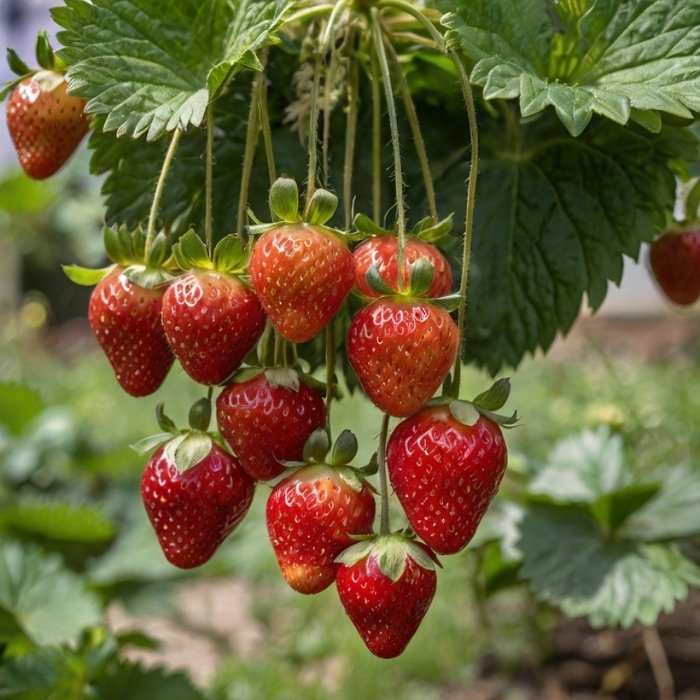Hanging Strawberries: A Complete Guide to Growing Strawberries in Hanging Baskets
Strawberries are one of the most beloved fruits, and for good reason. They’re sweet, versatile, and packed with nutrients. But what if you don’t have a large garden or enough ground space to grow them? Enter hanging strawberries—a creative and space-saving way to cultivate this delicious fruit. Whether you’re a seasoned gardener or a beginner, growing strawberries in hanging baskets is a fun and rewarding project. In this guide, we’ll walk you through everything you need to know to grow thriving hanging strawberries.
Why Grow Hanging Strawberries?
Before we dive into the how-to, let’s talk about why growing strawberries in hanging baskets is such a great idea:
- Space-Saving: Perfect for small gardens, balconies, patios, or even indoors.
- Pest Control: Elevating your strawberries keeps them away from ground-dwelling pests like slugs and snails.
- Better Airflow: Hanging baskets improve air circulation, reducing the risk of fungal diseases.
- Aesthetic Appeal: Hanging strawberry plants add a touch of greenery and beauty to your space.
- Easy Harvesting: No more bending over to pick your strawberries—they’re right at eye level!
Choosing the Right Strawberry Variety
Not all strawberry varieties are created equal when it comes to hanging baskets. Here are the best types to consider:
- Everbearing Strawberries: These produce fruit throughout the growing season, making them ideal for continuous harvests.
- Day-Neutral Strawberries: Similar to everbearing, these varieties aren’t affected by day length and produce berries consistently.
- Alpine Strawberries: These smaller, flavorful berries are perfect for hanging baskets due to their compact size.
Popular varieties for hanging baskets include ‘Tristar’, ‘Seascape’, and ‘Mara des Bois’.
How to Grow Hanging Strawberries: Step-by-Step Guide
1. Select the Right Basket
Choose a hanging basket that’s at least 12-16 inches in diameter and has good drainage. Strawberries have shallow roots, so a wide, shallow basket works best. Consider using coco liners or plastic-lined wire baskets to retain moisture.
2. Use Quality Potting Mix
Strawberries thrive in well-draining, slightly acidic soil (pH 5.5-6.5). Use a high-quality potting mix enriched with organic matter like compost or aged manure. Avoid garden soil, as it can compact and hinder root growth.
3. Plant Your Strawberries
- Fill the basket halfway with potting mix.
- Gently remove the strawberry plants from their nursery pots and loosen the roots.
- Place 3-5 plants around the edges of the basket, spacing them evenly.
- Add more soil, leaving about an inch of space at the top for watering.
- Water thoroughly after planting.
4. Hang in the Right Location
Strawberries need 6-8 hours of sunlight daily, so choose a sunny spot for your hanging basket. If you’re growing them indoors, place them near a south-facing window or under grow lights.
5. Water Regularly
Hanging baskets dry out faster than ground soil, so check the moisture level daily. Water when the top inch of soil feels dry, but avoid overwatering, as strawberries don’t like soggy roots.
6. Fertilize for Optimal Growth
Feed your hanging strawberries every 2-3 weeks with a balanced, water-soluble fertilizer (10-10-10 NPK). Alternatively, use organic options like fish emulsion or compost tea.
7. Prune and Maintain
Remove any dead leaves or runners to encourage healthy growth and fruit production. Runners are stems that grow outward and can drain energy from the main plant.
Tips for Success with Hanging Strawberries
- Rotate the Basket: Turn the basket every few days to ensure all sides receive equal sunlight.
- Mulch the Soil: Add a layer of straw or pine needles to retain moisture and regulate soil temperature.
- Protect from Birds: Use netting to keep birds from feasting on your strawberries.
- Overwintering: In colder climates, bring your hanging baskets indoors or insulate them to protect the plants from frost.
Common Problems and Solutions
1. Yellowing Leaves
This could be due to overwatering, nutrient deficiency, or poor drainage. Adjust your watering schedule and ensure the soil is well-draining.
2. No Fruit
Lack of sunlight, improper fertilization, or overcrowding can prevent fruiting. Make sure your plants get enough light and space.
3. Pests
Aphids, spider mites, and slugs can attack your strawberries. Use insecticidal soap or neem oil for pests, and keep the basket elevated to deter slugs.
4. Fungal Diseases
Powdery mildew and gray mold can occur in humid conditions. Improve airflow and avoid overhead watering to prevent these issues.
Creative Ideas for Displaying Hanging Strawberries
- Vertical Garden: Combine multiple hanging baskets to create a stunning vertical strawberry garden.
- Tiered Hangers: Use tiered plant stands to display several baskets at different heights.
- Indoor Décor: Hang baskets near windows or in sunrooms for a fresh, fruity touch to your interior design.
- Gift Idea: A hanging strawberry basket makes a unique and thoughtful gift for gardening enthusiasts.
Health Benefits of Strawberries
Growing your own strawberries isn’t just rewarding—it’s also healthy! Here are some reasons to enjoy this superfruit:
- Rich in Antioxidants: Strawberries are packed with vitamin C and polyphenols, which fight free radicals.
- Heart Health: They help lower blood pressure and improve cholesterol levels.
- Weight Management: Low in calories and high in fiber, strawberries are a great addition to a healthy diet.
- Skin Benefits: The antioxidants in strawberries promote glowing, youthful skin.
Frequently Asked Questions (FAQs)
1. Can I grow hanging strawberries indoors?
Yes! As long as they receive adequate sunlight or artificial light, strawberries can thrive indoors.
2. How long does it take for hanging strawberries to bear fruit?
Most varieties start producing fruit within 4-6 weeks of flowering.
3. Can I grow hanging strawberries from seeds?
While possible, it’s easier and faster to grow strawberries from seedlings or bare-root plants.
4. How many strawberry plants can I grow in one basket?
A 12-16 inch basket can comfortably hold 3-5 plants.
Final Thoughts
Growing hanging strawberries is a fantastic way to enjoy fresh, homegrown fruit even if you’re short on space. With the right care and attention, your hanging baskets will yield a bountiful harvest of juicy, sweet strawberries. Plus, they’ll add a beautiful, vibrant touch to your home or garden.
So, why wait? Grab a basket, some strawberry plants, and get started on your hanging strawberry adventure today. Happy gardening!

